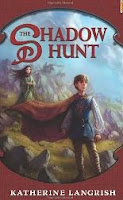The Shadow Hunt (Dark Angels in the UK) is a medieval fantasy with folklore and myth woven seamlessly into the story. A YA novel, it nevertheless, provided me with several hours of good entertainment.
This was a buddy read with Kailana.
This was a buddy read with Kailana.
What age group do you think the novel would most appeal to and why?
The book is targeted toward the younger end of the YA spectrum, 9-12 year olds, I think. It lacks the more adult trend of including more mature subject matter, especially romantic/sexual aspects/contemporary sophistication.
There is a good introduction to some early medieval history (12th C.) and to myth and fairy tale of the period that could serve a young person well in future reading. For a young reader, I believe the suspense and supernatural elements would be appealing.
What did you think of the way Langrish handled the treatment of the Church?
By presenting remnants of earlier local traditions that allowed priests to marry and by including acceptance of supernatural and pagan beliefs, she shows how Christianity overlaid earlier pagan beliefs. As in Beowulf, the earlier pagan beliefs are the foundation, and on that foundation, Christian theology and beliefs have taken root.
Howell, the kind castle priest, is an example of this easy mixture of older pagan beliefs and the basic tenets of Christianity.
Brother Thomas, however, despises earlier beliefs and exemplifies a more rigid adherence to theology while at the same time being a thoroughly unsympathetic character, more concerned with his personal place in a power structure than with Christian tenets. He is an abuser of power and represents the less savory aspects of the Church.
Who was your favorite character and why?
My favorite character is the Hearth Hob. The hob, a small hairy sprite who lives in the castle, is helpful in some situations and quite a nuisance, full of mischief, in others. Hobs, hobgoblins, and hobbits? I like the evolution of these small creatures.
I'm going to also add here that Halewyn is one of the more interesting characters. Friendly and frightening, Halewyn provides a dark and threatening personality, different from Brother Thomas and Lord Godfrey who are, in a sense, his tools. His agenda is much more far-reaching.
Do you think most YA readers would understand Hugo's obsession? Nest's resignation to her prospective marriage?
Yes, I do think that young readers would have a grasp of Hugo's grief over the loss of his beloved wife and his desire to somehow "rescue" her. The maturity level of the reader would play an important part here for a deeper understanding, but Hugo's sense of love and loss would be understandable.
Nest's resignation to her prospective marriage, especially at such a young age, would require much more effort, I think, from a modern reader. This is a cultural difference that is more difficult for a modern young person to understand than is Hugo's obsession with rescuing his wife from the fairies.
How did you feel about Langrish's use of folk lore and fairy tale?
I liked the way Langrish used so many themes of folklore and fairy tale. From fairies, hobs, ghosts, angels, and the wild hunt (or a version of it), Langrish manages to include both the benevolent and the malevolent aspects of myth and fairy tale.
The inclusion of all of the myth and folklore helps develop better future readers, in my opinion. The better the background one has in nursery rhymes, folklore, fairy tales, myth, and Bible stories, the better the understanding and appreciation one has of literature.
Literature is rife with allusion, and these allusions provide so much more pleasure and insight into both prose and poetry.
Literature is rife with allusion, and these allusions provide so much more pleasure and insight into both prose and poetry.
Overall Evaluation:
Definitely geared to a younger, pre-teen audience, the book has a lot to offer.
Strangely, I didn't feel any particular attachment to Nest, Wolf, or Elfgift. However, I remember that in reading Troll Fell and Troll Blood, I was impressed with the way the characters had grown. Maybe that will be the case here; if Nest and Wolf make another appearance in a new story-- maybe they, too, will grow in complexity.
Still, for the 9-12 age group, this will be an engaging read.


No comments:
Post a Comment